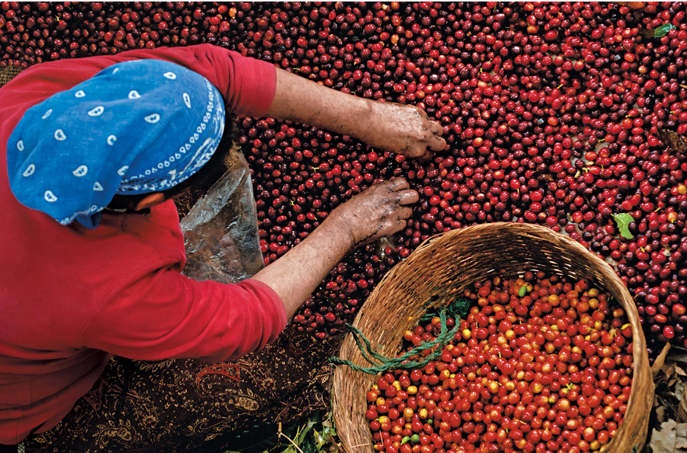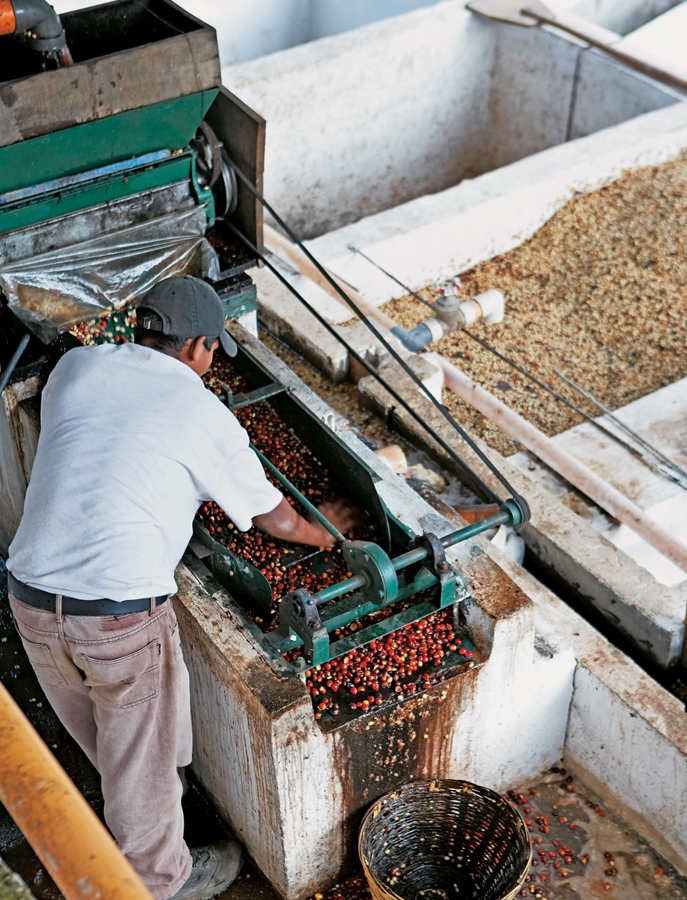Careful harvesting of coffee cherries is fundamentally important to the quality of the resulting cup of coffee. Unsurprisingly, coffee beans harvested from fruit at peak ripeness generally taste the best. Many experts see the harvest as the point at which the quality of the coffee peaks, and every stage thereafter is about preserving quality rather than improving it.
The greatest challenge in harvesting high-quality coffee is perhaps the topography of the land on which the coffee is growing. Great coffee requires altitude and many coffee farms are located on steep slopes in mountainous areas. Simply navigating between the trees can be difficult, if not downright dangerous. This isn’t true of every coffee farm, however.
MACHINE HARVESTING
Brazil has large areas of flat land at high altitude where coffee proliferates. The estates in these areas drive large machines down the neat rows of coffee trees to harvest the cherries. These machines essentially shake the trees until the fruit comes loose. There are numerous downsides to machine harvesting, the biggest being the issue of collecting fruit before it is necessarily ripe. The cherries on the branch of a coffee tree ripen at different rates, so each branch has both ripe and unripe cherries together. The machines do not differentiate and pick all the cherries at once. This means they must be sorted after harvest to separate the ripe from the unripe, and to discard the twigs and leaves that also get shaken off the tree. The cost of the coffee’s production will be lower than any other harvesting method, but at the expense of the quality of the harvest as a whole.
STRIP PICKING
A great deal of coffee is still harvested by hand as machines simply cannot operate in hilly areas. One of the faster methods of hand-picking is to strip all the cherries off a branch together with one deft movement. Like machine harvesting, this is a quick but imprecise way to pick the cherries. It doesn’t require expensive equipment or flat land, but still results in a mixed bag of ripe and unripe cherries that must be sorted later.
HAND-PICKING
For high-quality coffee, hand-picking remains the most effective way of harvesting. Pickers select only the cherries that are ready for harvest, leaving the unripe fruit on the tree to be picked later. This is hard labour and producers face the challenge of incentivizing their pickers to harvest only the ripe fruit. Pickers are paid by the weight of the fruit they pick, which encourages them to pick unripe fruit to make up additional weight. Quality-conscious producers have to work carefully with their picking teams to make sure they are also paid for uniform ripeness.
 Cherries can be sorted in a flotation tank. Ripe cherries sink to the bottom of the tank and are pumped out for processing while unripe fruit floats to the top and is treated separately.
Cherries can be sorted in a flotation tank. Ripe cherries sink to the bottom of the tank and are pumped out for processing while unripe fruit floats to the top and is treated separately.
FALLEN FRUIT
Coffee growers collect any fruit that naturally falls off the trees – ripe or not. This is usually collected separately and will become part of the lower quality lots that even the best farms in the world inevitably produce. Leaving fallen fruit on the ground under the trees can cause problems, as they tend to attract pests such as coffee berry borer.
THE PROBLEMS OF LABOUR
The cost of hand-picking coffee is proving a growing challenge and contributes a large part of the production costs. This is one of the primary reasons that coffees produced in developed economies – such as Kona coffees produced in Hawaii – are so expensive. In rapidly developing countries, people simply don’t want to pick coffee for a living. Coffee farms in Central America often employ itinerant pickers who travel from country to country, as different regions harvest at slightly different times. Currently, many of these workers are from Nicaragua as it is the weakest economy in the region. Finding people to harvest coffee is likely to continue to be a challenge, and in fact at one stage Puerto Rico was using its prisoners to harvest coffee.
SORTING THE BEANS
After picking, the cherries are often sorted using a variety of different methods to prevent unripe or overripe coffee from joining the bulk of the lot. In parts of the world with relatively low labour costs, and little money available for investment in equipment, this is done by hand.
In more developed countries, the cherries are often sorted using a flotation tank. The cherries are poured into a large tank of water, where the ripe fruit sinks to the bottom. They are pumped from there into the main processing section. Unripe fruit floats to the top and is skimmed off to be processed separately.
 Where labour costs are low, cherries are picked by hand to maximize the harvest of ripe fruit.
Where labour costs are low, cherries are picked by hand to maximize the harvest of ripe fruit.
 A worker in El Salvador sorts hand-picked fruit.
A worker in El Salvador sorts hand-picked fruit.
 Cherry harvests are processed at a wet mill, where beans are separated from the parchment and then dried, ready for storage and shipping.
Cherry harvests are processed at a wet mill, where beans are separated from the parchment and then dried, ready for storage and shipping.